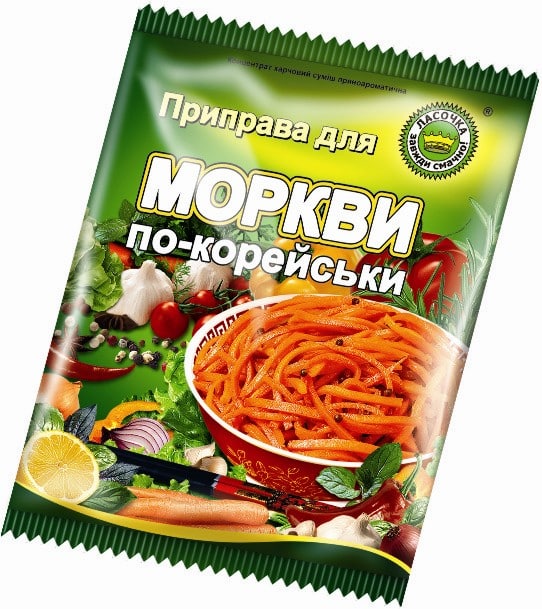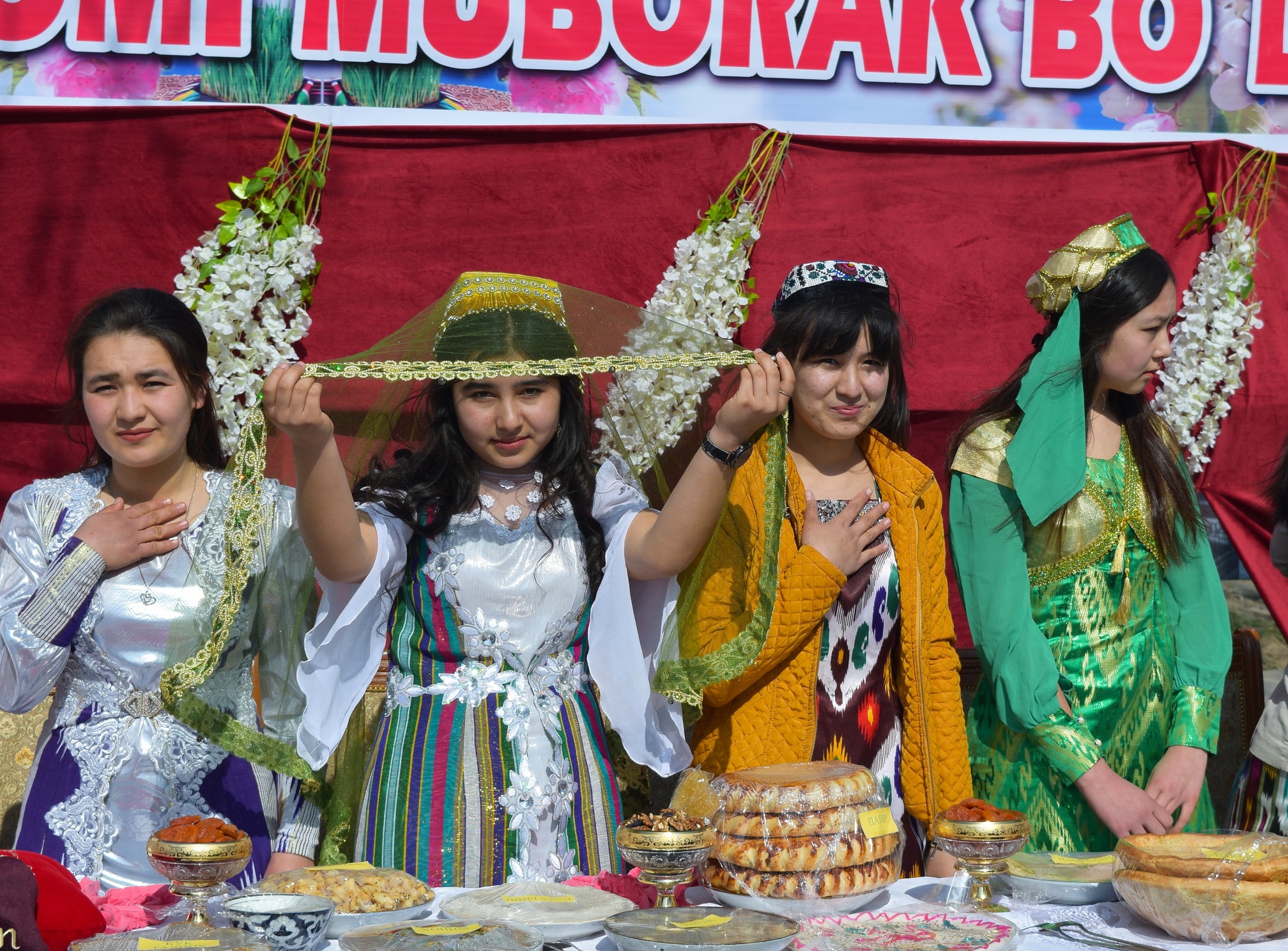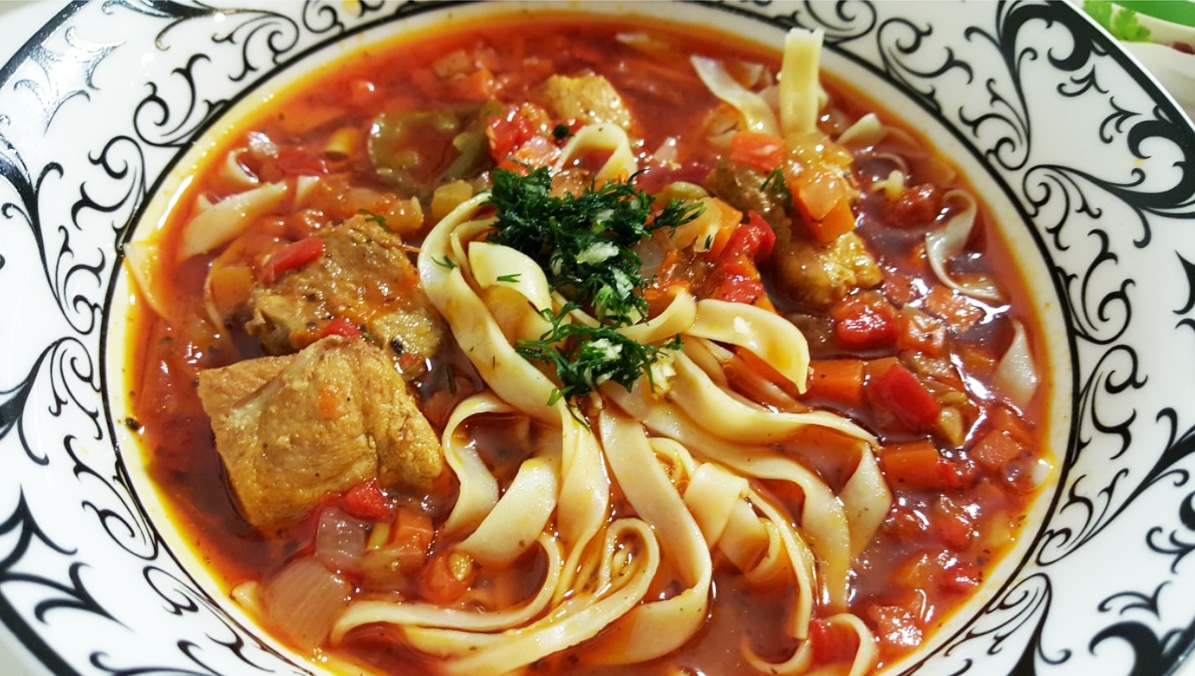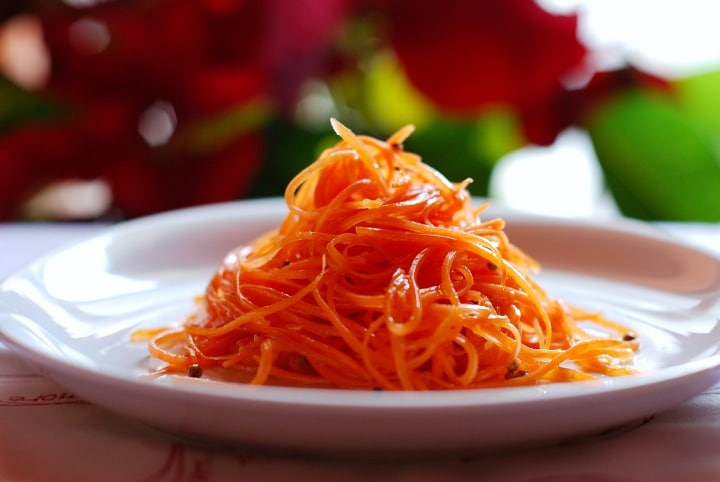Korean Carrot Salad (Морковь по-корейски, also called корейская морковь/морковка) was a Soviet-era invention of the “Корё-сарам” (Koryo-Saram), ethnic Koreans living in the territory of the former Soviet Union. The salad was inspired by traditional Korean cuisine, and was shaped by the shortages and circumstances of life in the Soviet Union. It originated in Central Asia but became immensely popular across regions and ethnicities throughout the USSR. The simple, flavorful shredded salad is spicy, vinegary, carrot-sweet, and intense. It has remained a major side-dish in Russia, Ukraine, and Central Asia.
How It Got Its Name
(Почему она носит такое название?)
The Koryo-Saram descend from ethnic Koreans who lived and thrived in the Russian Far East until a brutal deportation under Stalin in 1937. Most of the Korean population in the Russian Far East had settled there from 1860-1930, as a result of economic hardship and the Japanese annexation of Korea. In 1937 the NKVD reported that the Japanese were making use of Korean spies in the region. Stalin soon had 171,781 Koreans from the Russian Far East deported to Central Asia. 40,000 people are estimated to have died as a result of the deportation. After suffering through difficult early years, the deportees developed rice farms and economic stability in the Kazakh and Uzbek SSRs. They also adapted their cuisine to local conditions.
Korean Carrot Salad is based on Korean banchan: small dishes traditionally served alongside rice. It perhaps most closely resembles kimchi, a dish of fermented, spiced vegetables. The vegetables often used by the Koreans, including cabbage and seaweed, were difficult, if not impossible, to come by in Soviet Central Asia. Carrots were plentiful, however, and supplemented and eventually replaced other vegetables in the cold salad that became Korean Carrot Salad. Tossed with vinegar, oil, garlic, and spices, the salad also seems to reflect somewhat the Russian palate. The dish was, until recently, virtually unknown in South Korea.
How to Eat Korean Carrot Salad
(Как правильно есть морковь по-корейски?)
The popularity of Korean Carrot Salad has spread far beyond the Koryo-Saram community. It is now widely found in supermarkets, cafeterias, and restaurants throughout most of the former Soviet Union. Packets of spice mix for the salad are also widely available in store and it is often prepared at home as a side dish, from scratch or from a mix, by people of various ethnicities in post-Soviet states. Numerous recipes are available in Russian online. The dish has even made it to the diaspora of Bukharan Jews (from Central Asia) in New York, where it can be found on the menu in many Bukharian restaurants.

How to Prepare Korean Carrot Salad
(Как правильно готовить морковь по-корейски?)
Carrots are the crux of this dish. They are thinly shredded, and remain raw in the final product. The salad’s flavor comes from vinegar, oil, and spices, which can be varied. Ground coriander and black pepper are often used, as is hot red pepper for a spicy version of the dish. Chopped garlic is generally included, and paprika can also be added. The oil is the only part of the dish that is often cooked: vegetable, sunflower, or cottonseed oil is heated in a pan before being poured into the carrot mixture. Chopped onions are sometimes cooked in the oil to add flavor, and then removed before the oil is mixed in or left to remain. Vinegar, in varying amounts, is also an important part of the dish. Salt, to taste, is usually added, and sugar sometimes is as well. Korean Carrot Salad is said to taste best after sitting in the refrigerator for several hours.
The dish is such a staple of cuisine in the post-Soviet world that a julienne grater will generally be marketed as a special “тёрка” (grater) for making the dish. Packs of spices premixed for the salad are also sold.
Once prepared, often only one ingredient is visible in Korean Carrot Salad: shiny, shredded carrots ‒ sometimes with flecks of black or green depending on what spices have been used. But the many invisible ingredients are apparent in the salad’s surprisingly rich flavor. The strips of carrots are usually long and thin enough to twirl around a fork, like spaghetti, and eat in large, crunchy mouthfuls.
Korean Carrot Salad Recipe
(Давай приготовим!)
| Морковь по-корейски | Korean Carrot Salad |
Ингредиенты
Приготовление
|
Ingredients
Preparation
|
Our Favorite Korean Carrot Salad Videos
This is a clear, no-nonsense demonstration of a Korean Carrot Salad recipe.
This video, full of almost-over-the-top kitsch, is by a Korean-Russian who runs his own YouTube channel devoted to Korean cooking.
You Might Also Like

Jewish Bishkek: A Brief History and Guide
Though the concrete details of Jewish presence in the area of Kyrgyzstan itself is largely unknown before the Soviet Union, Bukharian Jews have resided there since the 4th century. In the modern day, the population of Jews in Kyrgyzstan is estimated to be approximately 500 with most located in Bishkek. For visitors and locals alike, […]

Navruz, Nooruz, Nowruz: The Ancient Spring New Year of Central Asia
Navruz is a spring solstice celebration that marks the beginning of the New Year according to the traditional Persian calendar. It has been a beloved holiday for some 3,000 years, surviving cultural change caused by centuries of tumultuous history. It was once celebrated on the vernal equinox but is now celebrated on the set date […]

The Women Who Shaped Kyrgyzstan
In traditional Kyrgyz culture, women have been long regarded as the keepers of culture, the managers of the household, and nurturers of children. Despite this vaunted position, Kyrgyzstan remains, overall, a patriarchal society and women are also often expected to be quiet and submissive. Below are several Kyrygz women who have broken that mold. They […]

Kyrgyz Holidays 2024: A Complete Guide
Kyrgyz holidays include many inherited from the USSR (although most of those have changed their form at least slightly). Kyrgyz holidays also include many adopted from Russian culture. However, many holidays have now been added to the calendar to celebrate patriotism toward independent Kyrgyzstan and Kyrgyzstan’s long-held Muslim heritage. Thus, Soviet, national, Orthodox, Muslim, modern, […]

Lagman: The Noodles of the Silk Road
Lagman is a dish that is very common in Central Asia, China, and many Middle Eastern countries. It can also be found in Russia and the Caucasus and is a popular dish among the Crimean Tatars. The basic recipe, which combines noodles with meat, has hundreds of variations. In Uzbekistan, the dish tends be a […]






